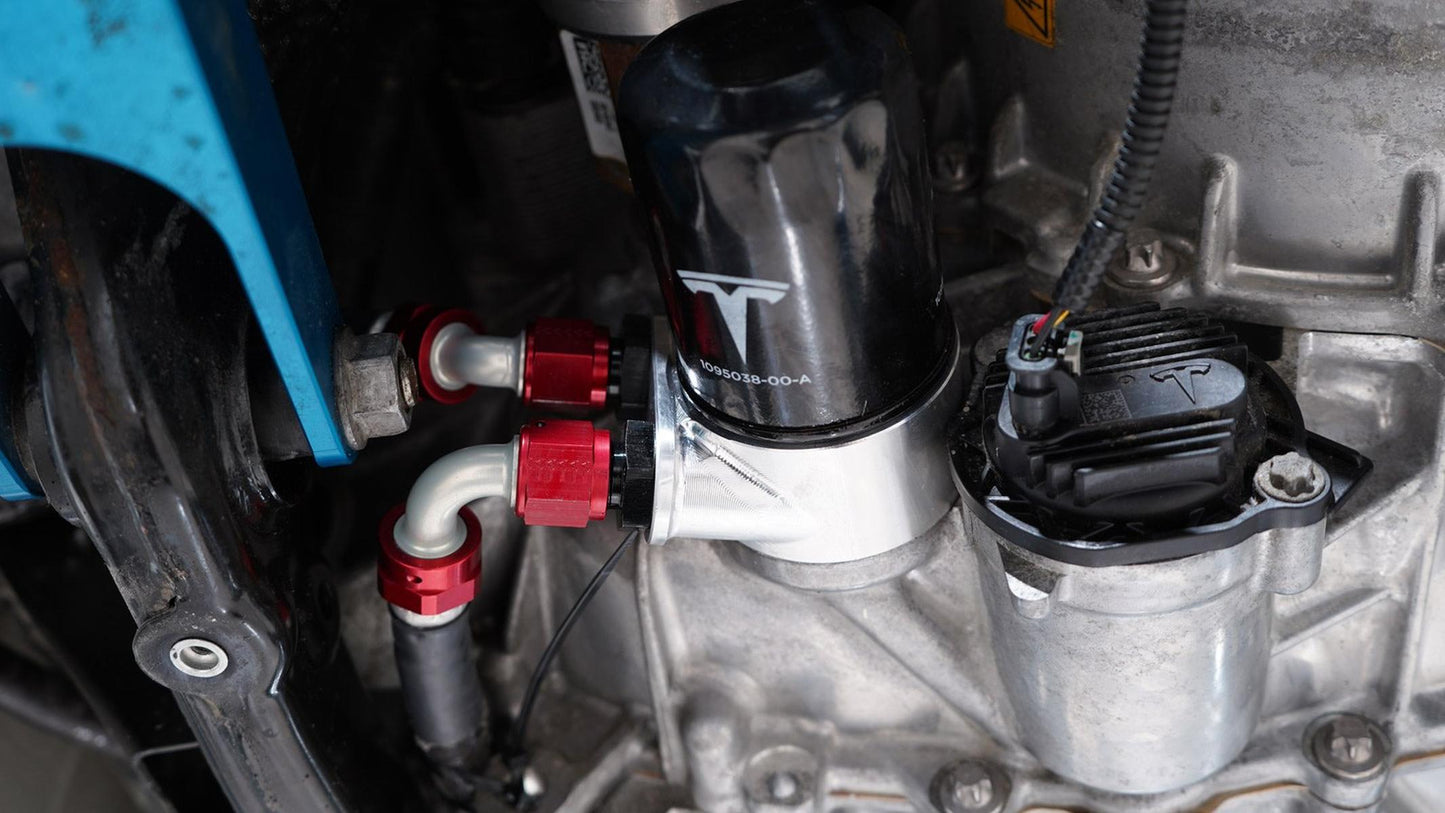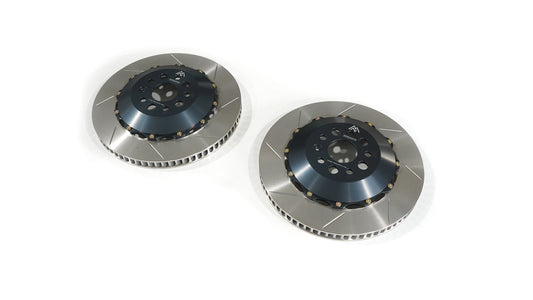



Innehåll som kan döljas
Beskrivning
Mountain Pass Performance Model 3 kylning för den bakre drivlinan. En plug and play lösning för dig som siktar på att pressa din bil maximalt på bana utan att få begränsningar i batteriet och drivlinan på grund av värme.
Mountain Pass Performance egna ord om deras kylning för bakre motorn på Model 3:
At MPP, it is our main concern to ensure we understand the car and its limitations before we design aftermarket parts. That is why before attempting to address the cooling system of the Model 3 we wanted to fully understand it – and ensure the products we develop will actually function in effectively removing heat from the system in the most efficient way possible. Our MPP.R Nür line of products focuses on cooling upgrades that will allow unrestricted laps of the entire Nürburgring Nordschliefe – the most demanding circuit in the world. This oil cooler is the first of a complementary kit of products that will be released over the winter of 2020/2021.
Theory:
The Model 3 has a very intricate cooling system which is composed of many different systems that interact in a dynamic way – that is to say, it’s not like your typical internal combustion engine with one coolant loop and one radiator! The Model 3 has a valve that can direct coolant through two different paths, an AC compressor that can run to cool down the coolant, and flaps that can block airflow to the radiator. On the oil side of the system – each drive unit has an electric oil pump which varies its flow, and this oil goes through a heat exchanger that transfers heat from the oil to the coolant system on the Model 3.
The purpose of the oil on the Model 3 rear-drive unit is to remove heat from the stator (the outer part of the motor) and the rotor (the center of the motor). The drive unit oil also lubricates and cools the gear reduction and differential. These are the hottest parts of the system, and as such on the racetrack the drive unit oil is the hottest fluid on the vehicle.
The stator and rotor are also where limits of the rear drive unit commonly show up, as the stator and the magnet inside the rotor are the items that exceed their thermal limits on the racetrack. These limits are quite high – with the stator being allowed to run at around 115 degrees C.
On the opposite end of the spectrum, we have the battery, which is thermally limited around 60 degrees C, but has such a small amount of thermal transfer due to the small interface of the cooling channels against the battery cells, that coolant temperatures around 30 degrees C are really required to keep the battery cool while on track. This is where the AC system comes into play, as it is able to cool the battery water loop sub-ambient temperatures.
Under normal track circumstances, the Tesla cooling system will focus the AC compressor’s cooling output to the battery, lowering the battery coolant temperature. The radiator will be solely in charge of cooling both drive units. Eventually, the powertrain gets too hot, and the system needs to use the AC compressor to cool both the powertrain and the battery, at which point the system quickly overheats as the battery inlet temperature rises, resulting in battery limiting.
Design:
Now let’s talk a little bit more about the product. As with all MPP designed parts, we wanted something that was very straightforward to install without needing special tools or experience. We ended up designing our own oil takeoff plate to have the lowest pressure drop possible, and removing the thermostat – as most aftermarket oil takeoff plates have a thermostat that open only at temperatures far above what our drive unit will ever reach! Since the drive unit controls the oil flow, the concern about “overcooling” the oil is not something we’re too concerned with. At low temperatures, the oil is just sitting in the drive unit not circulating for the most part, and even when it is circulating without the fan running there is no airflow across the core, so preheating the battery on a drive to a supercharger is a non-issue.
The lines we’ve used are Aeroquip StartLite hoses with professionally crimped ends. These are the same type of hose assemblies you would find on REAL professional racecars. The hoses are covered in thin fire sleeving for additional protection. The cooler itself is a Setrab unit – only the best for MPP customers. The cooler has an integrated fan which moves a TON of air. One of the reasons this is such a great solution is that it negates the need for complicated ducts and piping of air through the back of the car. The removal or customization of the rear plastic trim above the diffuser allows fan airflow to exit in the low-pressure area behind the bumper.
Oil cooler mounting is achieved with laser-cut, CAD-designed brackets that mount to existing locations.
Future expandability is provided by a 1/8″ NPT port and a solid-state relay (MPP SSR) that we have designed inhouse, which includes over-current protection. With the purchase of our solid-state relay, you can use either an oil-temperature switch or a manual toggle switch to cycle the cooler through a protected circuit. For those of you with a MoTeC dash, you can also use the dash to run the oil cooler however you’d like.
We’re quite proud of the design of this product as we feel it covers a number of different areas quite well, from theory to fit and finish. We feel strongly that if you track your car regularly you’ll want both these rear and eventually front drive unit oil coolers to extend your enjoyment of on-track driving, with no compromises.
Validation:
The first aspect of our testing was with our Long Range RWD Model 3, which has the same rear-drive unit as the AWD Model 3’s. Keeping the starting temperature reasonably close, we performed successive 60-110km/h accelerations with full regen and braking in-between. The average power was about the same as you’d find on the track. With the oil cooler installed but fan unplugged (so better than no oil cooler, but not by much) – the oil temperature increased at a rate of 3.0 degrees per minute. With the fan on, that rise was 2.5 degrees per minute, and the powertrain coolant loop was kept 8 degrees C cooler by the end of the test. The oil temperature wasn’t significantly cooler – remember the heat exchanger doesn’t have to work as hard – that is why the powertrain coolant temperature is so much lower.
With the fan running, stator temperature was also down by 8 degrees C, and power limitation occurred much later compared to the test without the fan on. The power limitation also went away faster! Despite the battery being 2-4 degrees C hotter at the start of the test, the battery coolant temperature remained the same or cooler than the test without the fan on. In the graph below the colored traces are with the fan on. All of this data was captured with our MoTeC C125 display and logger kit.

The next aspect of our validation was a track test with our Long Range RWD Model 3. We controlled every aspect of the test, including 45-minute return drives from the Supercharger to the track to allow the battery and system ample time to cool down after the supercharger “heat-soaking” that is performed to maximize charge rate. Unfortunately, there was one thing we didn’t anticipate – the fact that the oil cooler would work so well that the car didn’t turn on the AC compressor! Since we don’t have track mode, the AC compressor only comes on when the system is overheating. Since that never happened, we effectively traded one cooling system for another – suggesting that the oil cooler removes nearly as much heat as the air conditioning system. Despite the lack of AC cooling the water loops, the stator temperature was down 25 degrees C in this test! Unfortunately without the AC running, we weren’t able to see how much longer the car would have been able to go without limiting power. That being said, the power limitation did occur a full lap later, indicating the cooler oil coming back to the motor made a measurable difference!
Here’s a detailed video of our oil cooler track test, where we were able to combine proper testing with a bit of fun on-track antics.

Kit Contents:
This MPP.R rear drive unit oil cooler includes the following:
- (1) Setrab fan-pack oil cooler
- (2) Setrab adapter fittings
- (2) Motorsport grade Aeroquip StartLite hoses with Aeroquip crimped oil lines, covered in lightweight firesleeve.
- (1) Custom MPP designed oil filter takeoff plate
- (1) Bracket and hardware kit allowing for a plug and play installation
- (1) 1/8″ NPT port allowing for temperature sensor/switch integration.
We are also completing beta testing of an affordable solid-state relay that we’ve developed entirely in-house for control of the oil cooler fan. The solid-state relay can operate on an oil temperature switch or manual switch to activate the fan. These kits will be available shortly for those looking for an elegant control solution. We personally would hate to add fuses and relays to a car that has none.
Specifikationer
| SKU | 11708 |
| GTIN | |
| Kategori | > Okategoriserat |
FAQ
Länkar
Övrigt
Leverans:
Varor som finns i lager skickas vanligtvis inom 1-2 arbetsdagar. Aktuellt lagersaldo ser du alltid live på hemsidan.
Beställningar som mottages innan kl. 13.00 skickas vanligtvis samma dag från vårt lager. Beställningar som slutförs efter detta klockslag eller på helger behandlas nästkommande arbetsdag. Vänligen observera att leveranstiden kan variera beroende på val av fraktsätt, samt mottagarland, med en generell leveranstid på 1-3 arbetsdagar för alla lagerförda varor. Vi kan inte garantera leveranstid inom 3 dagar under perioder med hög belastning eller oväntade förseningar hos fraktbolaget.
Viktigt att veta:
Vi kan tyvärr aldrig garantera att ett tillbehör eller en reservdel passar just din bil till 100 %. Så länge rätt modell och årsmodell är vald bör delen passa, men det kan ändå finnas variationer. Om du är osäker rekommenderar vi att du kontaktar oss innan beställning – vi hjälper dig gärna att kontrollera!
Önskar du montering?
Kontakta oss nedan för att få offert på montering
- När du gör ett urval uppdateras sidan.
- Öppnas i ett nytt fönster.





























